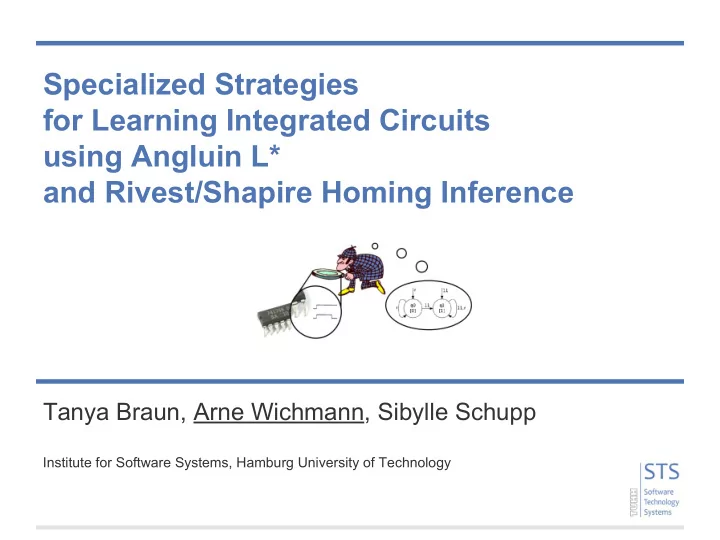

Specialized Strategies for Learning Integrated Circuits using Angluin L* and Rivest/Shapire Homing Inference Tanya Braun, Arne Wichmann, Sibylle Schupp Institute for Software Systems, Hamburg University of Technology
Blackbox Learning Digital ICs Angluin L*: Learning. - Stimulate, watch, learn. - Check and terminate on equivalence. R D CL 2
Blackbox Learning Digital ICs Rivest/Shapire homing: Missing reset. - Use homing sequence to recognize learner to be updated. 3
Blackbox Learning Digital ICs Problem: - Blackbox implies approximative equivalence. Use specialized strategies to check equivalence. 4 Figure based on Image By Mhinner (Own work) [Public domain], via Wikimedia Commons
Approximating: Engineering Stuff 5
Exploring State Space x-Axis: Input/alphabet. y-Axis: Time/steps/progress (to infinity). Baseline: Reset/homing/init. 6
Exploration Strategies Automata Strategies Densely connected. Alphabet stimulation from known states. Chain bridges. Toggle to find critical pins. Unknown. Random 7
Example Flip-Flop 8
Evaluation Results: Quality F1 Scores - Evaluation using 116 VHDL models of the 7400 series ICs (Free Model Foundry). - Case studies using real hardware. 9
Results: Quality and Cost F1 Score (blue) and Costs (green) relative to the maximum cost within a group in terms of queries per configuration and group of ICs; the red-colored F1 score and violet-colored costs indicate inconsistent data. 10
Conclusion - Strategies give good overall results. - Plain (Path + Alphabet) for the general case. - Counters need toggle for lookahead. - Engineering information (clear/clock) helps significantly. - Random based strategies did not perform well. (They usually trigger a reset or automata growth.) - Cost strongly depends on pin count/alphabet: - Abstract groups of pins to variables (arithm. ent.)? - Learning using sparse alphabets? 11
Recommend
More recommend